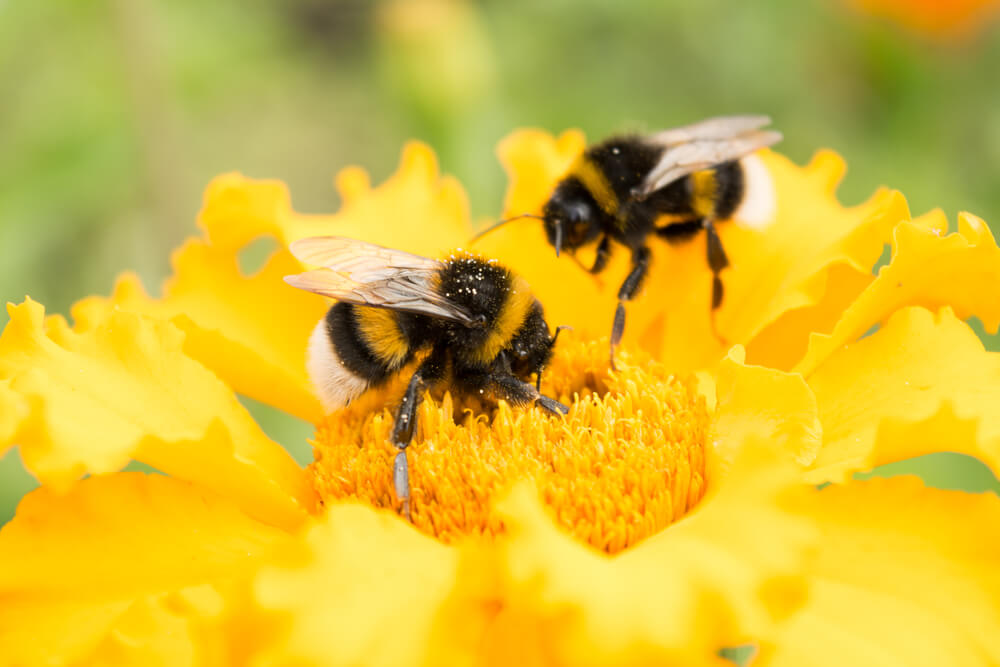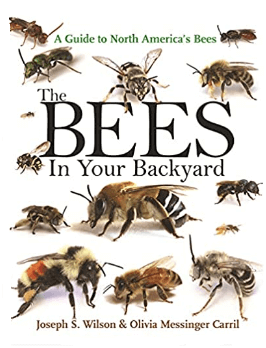Table of Contents:
Where Do Bees Live?
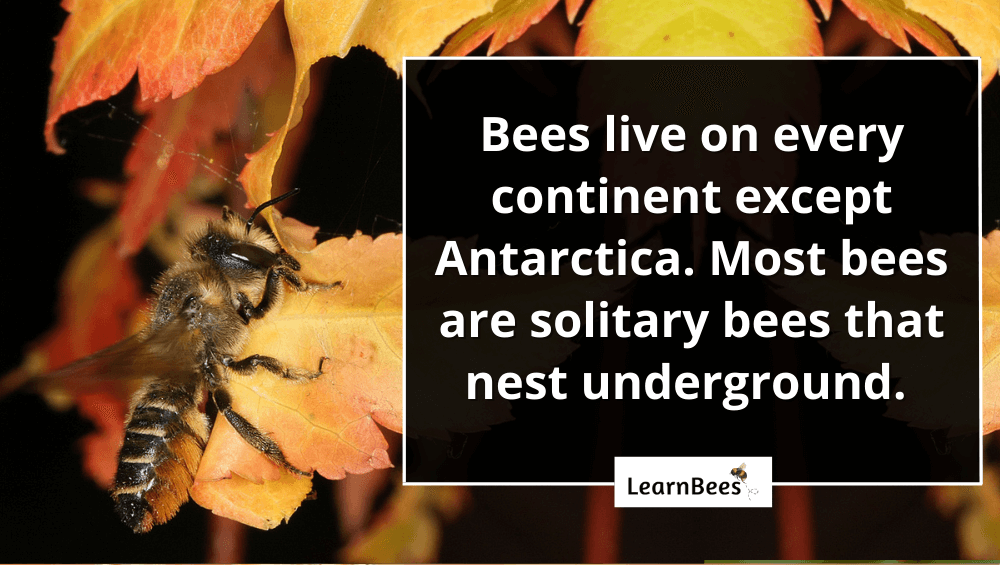
Bees are found on every continent except Antarctica.
In short:
There are bees wherever there are insect-pollinated plants—be it in forests, farms, cities, and wildlands. In fact, there are over 20,000 different bee species. Common examples include carpenter bees, honeybees, and bumblebees.
And here’s a fact that might surprise you:
Most bees are gentle creatures that won’t go out of their way to hurt you. They generally only sting if they feel in danger, like if you’re trying to squish them or stick your fingers around their nests.
Speaking of bee nests, most bee species nest underground in vacant rodent holes or other cavities.
In fact, bee nests are often so concealed that you may not even notice them.
This is because bees are particular about their nesting sites. They try to pick safe spots to house themselves or their colony.
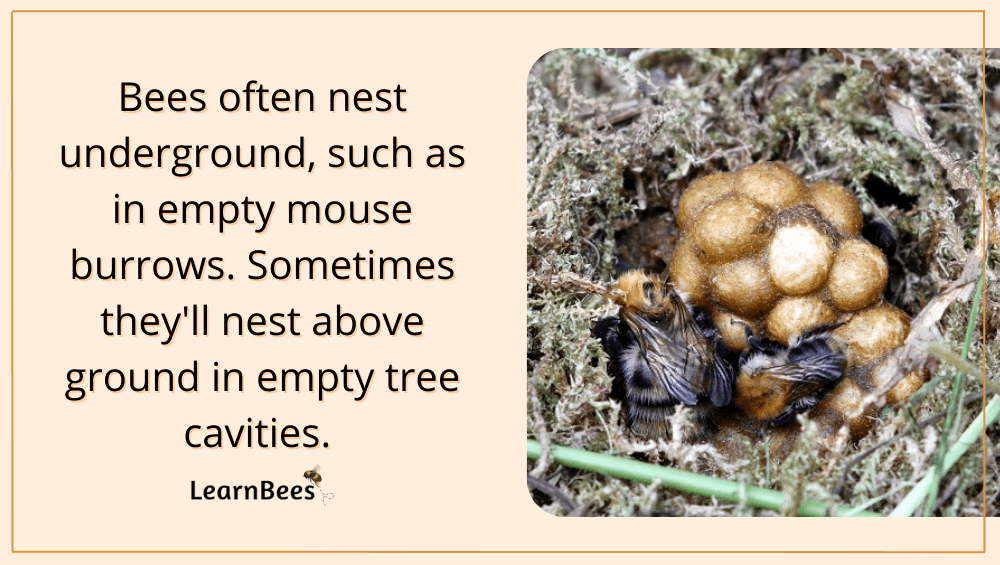
Remember:
Safety is vital for bees because they have countless amounts of predators.
This is especially true for bee species that produce honey, such as honeybees and bumblebees. Honey can make bees a target for honey-loving animals like honey badgers or bears. What’s more, many animals like to snack on bees and their larvae.
Birds, skunks, and even spiders have been known to feast on bees. In fact, a skunk can destroy an entire beehive in a matter of minutes.
Not good.
This is why it’s crucial to provide bees with distance when it comes to their nests. A bee’s primary job is to protect itself and its colony from potential threats.
As a result, you don’t want bees to mistake you for a predator.
With that in mind, keep an eye out for a bee’s warning signs to know whether you’ve stumbled upon a nest. Warning signals include buzzing around your face or over your head.
The good news?
Bees are usually gentle creatures that do well when they’re left alone.
You typically won’t have any problems if you don’t go digging around their nest.
Do All Bees Live in a Hive?
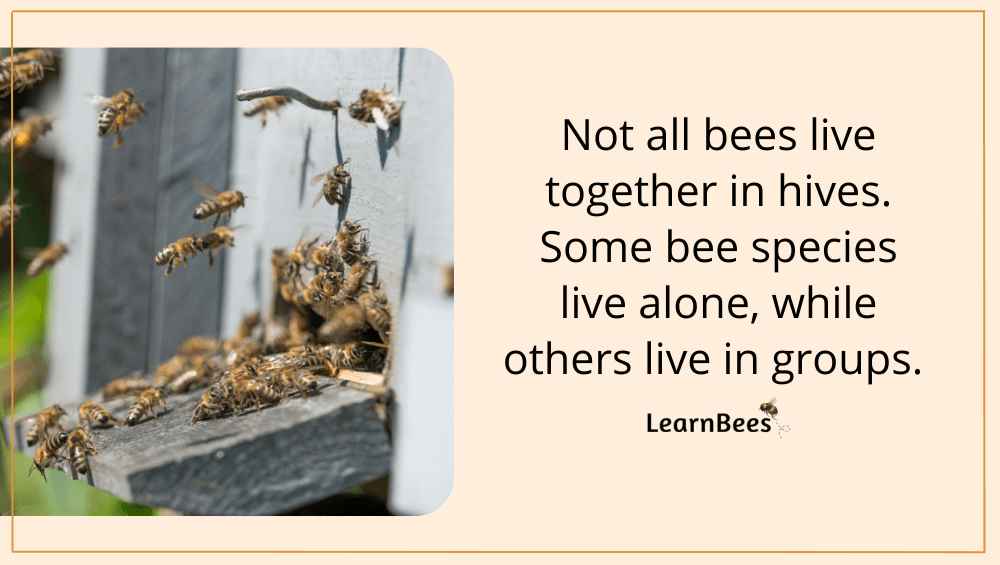
No, not all bees live together in hives with other bees.
For starters, most bees are actually solitary bees that live alone. It’s estimated that a whopping 75% of bees are solitary. Examples include carpenter bees, mason bees, and sweat bees.
Solitary bees don’t produce honey, nor do they have a queen bee. Each solitary female bee is responsible for building her own nest, collecting her own food, and defending herself.
Social bees are different.
Social bees, like honeybees and bumblebees, live together in big groups. Depending on the bee species, they can have anywhere from a couple hundred to several thousand bees in a single hive.
For example:
Bumblebee colonies can contain up to 500 bumblebees, while honeybees can have up to 60,000 honeybees.
And here’s the thing:
Social bee colonies are led by a female bee, also called the queen. The queen is the only bee in the hive that lays fertilized eggs, which makes her responsible for ensuring the future generation of the colony.
A large chunk of the hive consists of worker bees, which are all female. Worker bees have many duties, including caring for the colony by gathering nectar and pollen, producing honey, and feeding the bee larvae.
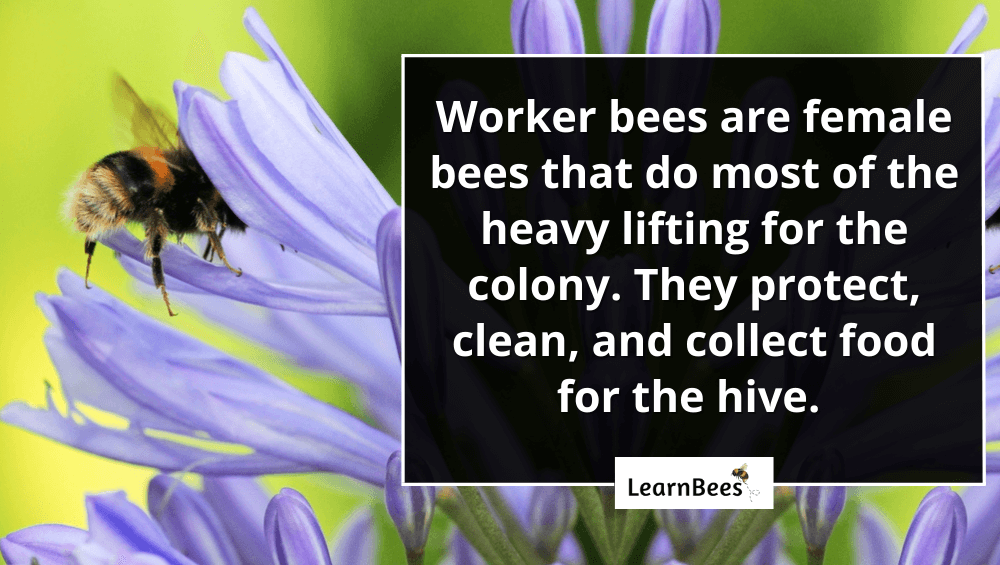
Male bees, or drones, don’t have many job duties other than mating with queens from other colonies. Once they’ve reproduced, their duty is fulfilled, and they typically don’t live much longer afterward.
With that in mind, most people are surprised to discover that bee colonies are made up of mostly female bees. As mentioned, female bees handle most of the hard work for the hive.
From defending the hive to searching for food, worker bees do it all. They’re vital to the colony’s survival and play a massive role in keeping things running smoothly.
So, what’s the bottom line?
Queen bees handle the egg laying, male bees handle mating with queens, and worker bees do almost everything else.
Bee colonies operate like well-oiled machines, with every bee completing specific duties they were born to do.
How Do I Find a Bees Nest?

Bees are typically good at concealing their nests. This is because they’re constantly under threat from intruders looking for a quick snack.
However, the easiest way to spot a bee nest is to lookout for underground cavities they gravitate towards. You can watch for bees flying in and out of these potential hiding spots to see if there’s a nest present.
Another way to spot a bee nest is to be aware of the apparent signs of a hive, such as hearing a buzz or humming noise near holes in the ground.
But keep in mind:
It’s essential not to harm the bee nests because bees are crucial pollinators.
It’s estimated that one in every three bites of food we eat is thanks to pollinators like honeybees, mason bees, and bumblebees.
In other words:
Without pollinators, our food supply would be drastically reduced.
This is why giving bees the space they need to thrive is essential.
FAQs on “Where Do Bees Live?”
- What is the name of a bee’s house?
- Where do bees make their nests?
- Where do bees live in the world?
- Do bees live underground?
- Do bees live alone?
- Where do bees go at night?
- Do bees nest in houses?
- Will a bee chase you if you’re near their nest?
- Why are there so many bees in my yard?
- How many bees live in a nest?
- Why am I finding bees in my house?
- How do you tell if you have a bee’s nest?
- Do bees nest in roofs?
- Do bees nest in chimneys?
- Where do bees live in the winter?
- What happens if you block the entrance to a bee’s nest?
What is the name of a bee’s house?
A bee’s house is called a hive or nest.
—> Go back to the FAQs on “Where Do Bees Live?”
More to Explore:
- Do Queen Bees Eat Honey?
- Are Worker Bees Male or Female?
- Queen Bee Versus Worker Bees – How Do They Compare?
Where do bees make their nests?
Most bees are solitary bees that nest underground. However, some species of bees, like honeybees, nest above ground in empty tree cavities.
—> Go back to the FAQs on “Where Do Bees Live?”
More to Explore:
- Do Carpenter Bees Pollinate?
- How Long Do Bumble Bees Live?
- Honeybees vs. Bumblebees: How Do They Compare?
Where do bees live in the world?
Bees are found globally in every continent except Antarctica. In the United States, native bees include carpenter bees, bumblebees, mason bees, sweat bees, and miner bees.
—> Go back to the FAQs on “Where Do Bees Live?”
More to Explore:
Do bees live underground?
Not all bees live underground.
However, most bees live underground in things like vacant rodent holes.
For instance, bumblebees typically form their nests in empty holes abandoned by other animals. You may be able to locate a nest by watching for bees flying in and out of such spots. With that in mind, it’s essential to provide bees with the necessary space so you don’t hurt their nests.
Despite being primarily gentle insects, bees protect their nests if they feel in danger.
—> Go back to the FAQs on “Where Do Bees Live?”
More to Explore:
- Ground Bees: Are They a Threat to Your Yard?
- Wasps vs. Honeybees: Are They Different?
- Do Bumble Bees Bite?
Do bees live alone?
Some bee species live alone, while others do not.
Bees that live alone are called solitary bees. Bees that live together in colonies are called social bees.
Social bee examples are honeybees and bumblebees. Solitary bee examples are mason bees, leafcutter bees, and sweat bees.
—> Go back to the FAQs on “Where Do Bees Live?”
More to Explore:
Where do bees go at night?
Bees are the most active during the daytime while collecting pollen and nectar from blossoms.
At night, bees return to their nests to sleep. That said, some bees stay active inside the hives at night while the other bees are resting. These ‘night shift’ bees work to keep the nest clean and take care of the other bees.
—> Go back to the FAQs on “Where Do Bees Live?”
More to Explore:
Do bees nest in houses?
Bees can nest in houses, but it’s not as common as you think.
Honeybees and carpenter bees are the two most common types of bees that nest in homes. For instance, honeybees will sometimes find small openings to come inside the home to build their nests, like gaps in the siding or cracks around windows.
Contrastly, carpenter bees make their nests by drilling holes into exposed wood.
Bumblebees are typically mistaken for carpenter bees because they look alike. However, they’re two different types of bees with varying nesting habits. That said, both carpenter bees and bumblebees are important pollinators.
—> Go back to the FAQs on “Where Do Bees Live?”
More to Explore:
Will a bee chase you if you’re near their nest?
Bees will buzz near you as a warning signal that you’re intruding upon their nest. In most cases, bees will leave you alone if you leave them alone.
For example, if you spot a honeybee buzzing around a blossom, there’s typically nothing to be concerned about. The honeybee isn’t in defense mode because she’s away from her hive and has nothing to protect. Instead, she’s doing her daily tasks, such as collecting pollen and nectar.
In contrast, if you see a honeybee constantly buzzing near your face or body, it’s usually trying to warn you to provide them with space away from their nest.
—> Go back to the FAQs on “Where Do Bees Live?”
More to Explore:
Why are there so many bees in my yard?
Bees are drawn to blooms because that’s where they collect their food from – aka pollen and nectar. So if your yard has flowers, that’s probably why you see multiple bees buzzing around.
Plus, you may notice bees in your yard if that’s where they’re nesting. Don’t be worried. You should be fine if you can give them several feet of distance from their nests. If you can’t, contact a local beekeeper to safely remove the nest without hurting it.
—> Go back to the FAQs on “Where Do Bees Live?”
More to Explore:
How many bees live in a nest?
It depends on the type of bee.
For example, bumblebees live in hives that can hold anywhere from 50 to 500 bees. Bumblebee colonies typically reach their peak size during summer.
Honeybees can live in hives that hold up to 60,000 honeybees.
Spring and summer are peak months for bees because many flowers bloom, which provide them with food sources.
As the temperatures cool down in the autumn, fewer flowers bloom. This shortage of food causes bee colonies to reduce in size. Once the harsh winter arrives, the bees either hibernate or go dormant.
—> Go back to the FAQs on “Where Do Bees Live?”
More to Explore:
Why am I finding bees in my house?
There are a couple of reasons why you might have a bee in your home.
For one, the bees could fly through crevices and cracks outside your home. This is most likely to happen if you have a flower garden near your home.
Secondly, bees may fly into your home through open windows or doors. Again, this is more likely to occur if you have a flower garden nearby.
Lastly, bees may nest in your home if there’s a crack or hole in your walls that the bee can use to get inside your home. Please call a local beekeeper to safely relocate the nest without damaging the colony if this is the case.
—> Go back to the FAQs on “Where Do Bees Live?”
More to Explore:
How do you tell if you have a bee’s nest?
The simplest way to tell is by checking out the area. If you notice several bees flying in and out of a particular spot, they’ll likely have a nest there.
Another tip is to listen for a buzzing noise around your home. Many bees make a buzz or humming noise which is more apparent when several bees are nesting together.
—> Go back to the FAQs on “Where Do Bees Live?”
More to Explore:
Do bees nest in roofs?
Bees will sometimes nest inside cavities near roofs. Calling a local beekeeper is best if you think there may be a bee’s nest in your roof. They’ll be able to remove the nest and relocate it.
—> Go back to the FAQs on “Where Do Bees Live?”
More to Explore:
Do bees nest in chimneys?
Bees will sometimes nest in chimneys. If you’re dealing with this issue, please contact a beekeeper to relocate the nest.
—> Go back to the FAQs on “Where Do Bees Live?”
More to Explore:
- Beehive on Ground: Are They a Problem?
- Bees Color: 10+ Types of Colored Bees With Pictures
- What Do Killer Bees Look Like?
Where do bees live in the winter?
Bees either hibernate or go dormant inside their nests during the winter.
—> Go back to the FAQs on “Where Do Bees Live?”
More to Explore:
What happens if you block the entrance to a bee’s nest?
Blocking a bee’s nest can harm the colony and irritate the bees.
If you block the entrance to a bee’s nest to the point where they can’t escape, the colony will die. As such, please don’t block access to a bee’s nest.
